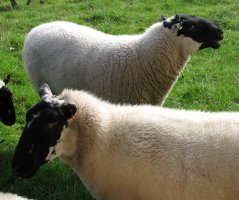Sheepshape
Herd Master
- Joined
- Oct 19, 2012
- Messages
- 1,706
- Reaction score
- 3,095
- Points
- 373
Yes, it's a real place.....Shropshire in the area near to the Welsh border....rolling hills etc. There's a village of Clun, too....population of 680 apparently...about 40 miles from where I live. The climate...cool. wet, typical valleys weather. Clun Forest sheep are tough sheep. I'm not aware of black faced sheep,,,,but here's a random pic of some of mine.....Beulah Speckled FaceThere's a real Clun Forest out there? Are there black faced sheep in it? The folks I got the sheep from said they'd picked the Clun Forest breed because they're supposed to do well in wet weather.



